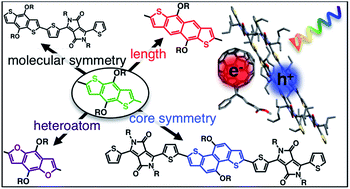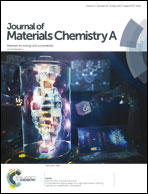Systematic evaluation of structure–property relationships in heteroacene – diketopyrrolopyrrole molecular donors for organic solar cells†
Abstract
Improved understanding of fundamental structure–property relationships, particularly the effects of molecular shape and intermolecular packing on film morphology and active layer charge transport characteristics, enables more rational synthesis of new p-type small molecules. Here we investigate a series of small molecules consisting of an acene-based electron-rich core flanked by one or two electron-deficient diketopyrrolopyrrole (DPP) moieties. Through minor changes in the molecule structures, measurable variations in the crystal structure and sizable differences in macroscopic properties are achieved. The molecular symmetry as well as the conformation of the side chains affects the unit cell packing density and strength of the intermolecular electronic coupling in single crystals of all molecules in this series. The addition of a second DPP unit to the benzodithiophene (BDT) core increases molecular planarity leading to decreased reorganization energy, strong cofacial coupling, and moderate hole mobility (2.7 × 10−4 cm2 V−1 s−1). Increasing the length of the acene core from benzodithiophene to naphthodithiophene (NDT) results in a further reduction in reorganization energy and formation of smaller crystalline domains (∼11 nm) when mixed with PCBM. Decreasing the aspect ratio of the core using a “zig-zag” naphthodithiophene (zNDT) isomer results in the highest hole mobility of 1.3 × 10−3 cm2 V−1 s−1 due in part to tight lamellar (d = 13.5 Å) and π–π stacking (d = 3.9 Å). The hole mobility is directly correlated with the short-circuit current (11.7 mA cm−2) and solar cell efficiency (4.4%) of the highest performing zNDT:PCBM device. For each of these small molecules the calculated π-coupling constant is correlated with the hole mobility as a function of crystal structure and orientation indicating the importance of designing molecules that create extended crystalline networks with maximal π-orbital overlap.



 Please wait while we load your content...
Please wait while we load your content...